Research Proposal: Employment Policies & Job Creation for Students
VerifiedAdded on 2021/06/15
|17
|4416
|74
Report
AI Summary
This research proposal investigates the impact of Australian employment policies on job creation for international students. It aims to understand current policies, particularly those affecting foreign students, and identify the governing bodies. The study seeks to determine available job opportunities and the policies regulating their acquisition, ultimately establishing the correlation between employment policies and job prospects for international students. The research addresses the literature gap concerning the impact of national employment policies on job creation, specifically focusing on the concerns that current policies may limit international students' work capacity, affecting economic growth. By answering key research questions, the findings will contribute to improved policy-making, fair workplace regulations, and a better understanding for international students navigating the Australian job market. The proposal also outlines a conceptual framework, defining employment policy, its application, and the challenges faced by international students due to restrictions on working hours, skill requirements, and compensation packages.
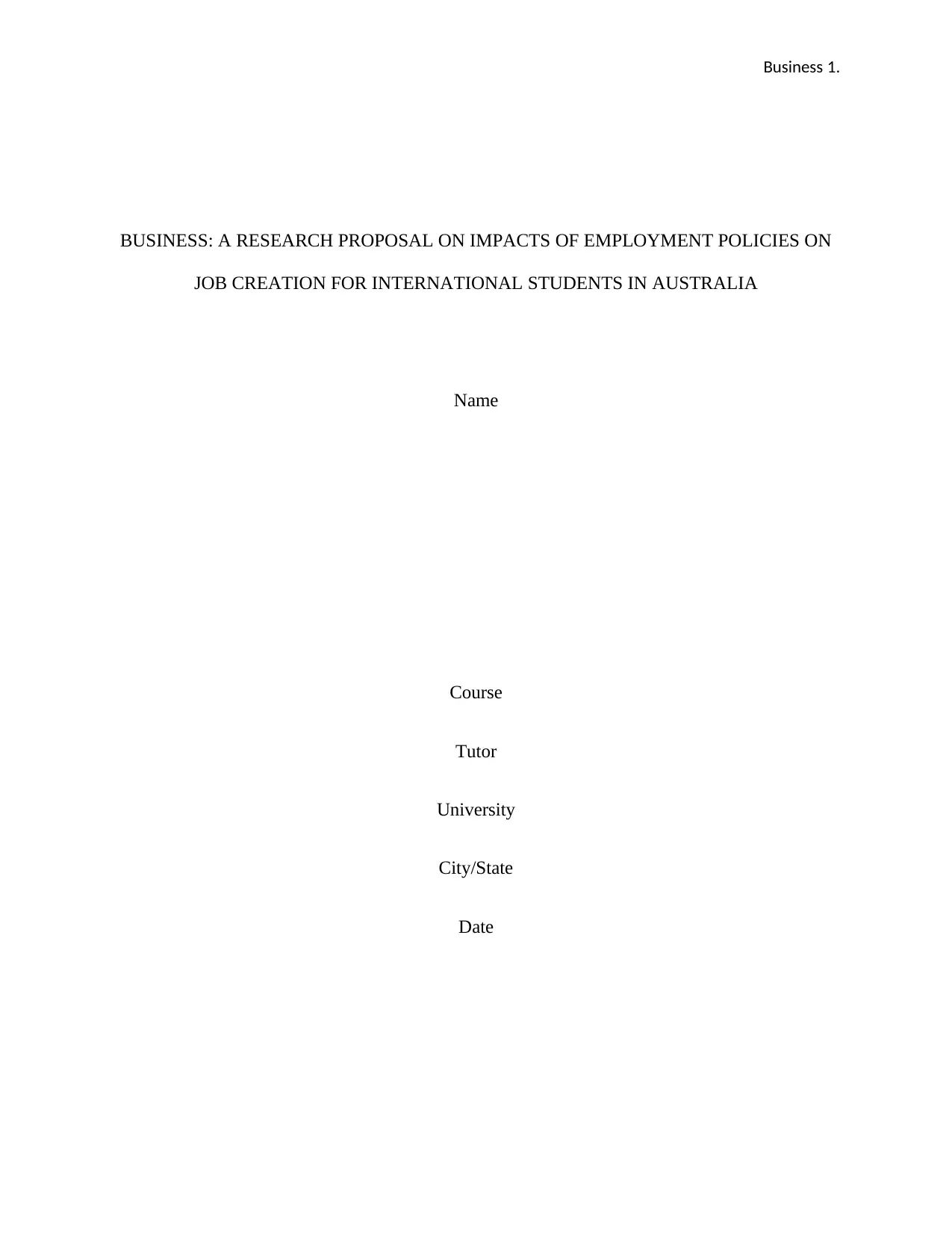
Business 1.
BUSINESS: A RESEARCH PROPOSAL ON IMPACTS OF EMPLOYMENT POLICIES ON
JOB CREATION FOR INTERNATIONAL STUDENTS IN AUSTRALIA
Name
Course
Tutor
University
City/State
Date
BUSINESS: A RESEARCH PROPOSAL ON IMPACTS OF EMPLOYMENT POLICIES ON
JOB CREATION FOR INTERNATIONAL STUDENTS IN AUSTRALIA
Name
Course
Tutor
University
City/State
Date
Paraphrase This Document
Need a fresh take? Get an instant paraphrase of this document with our AI Paraphraser
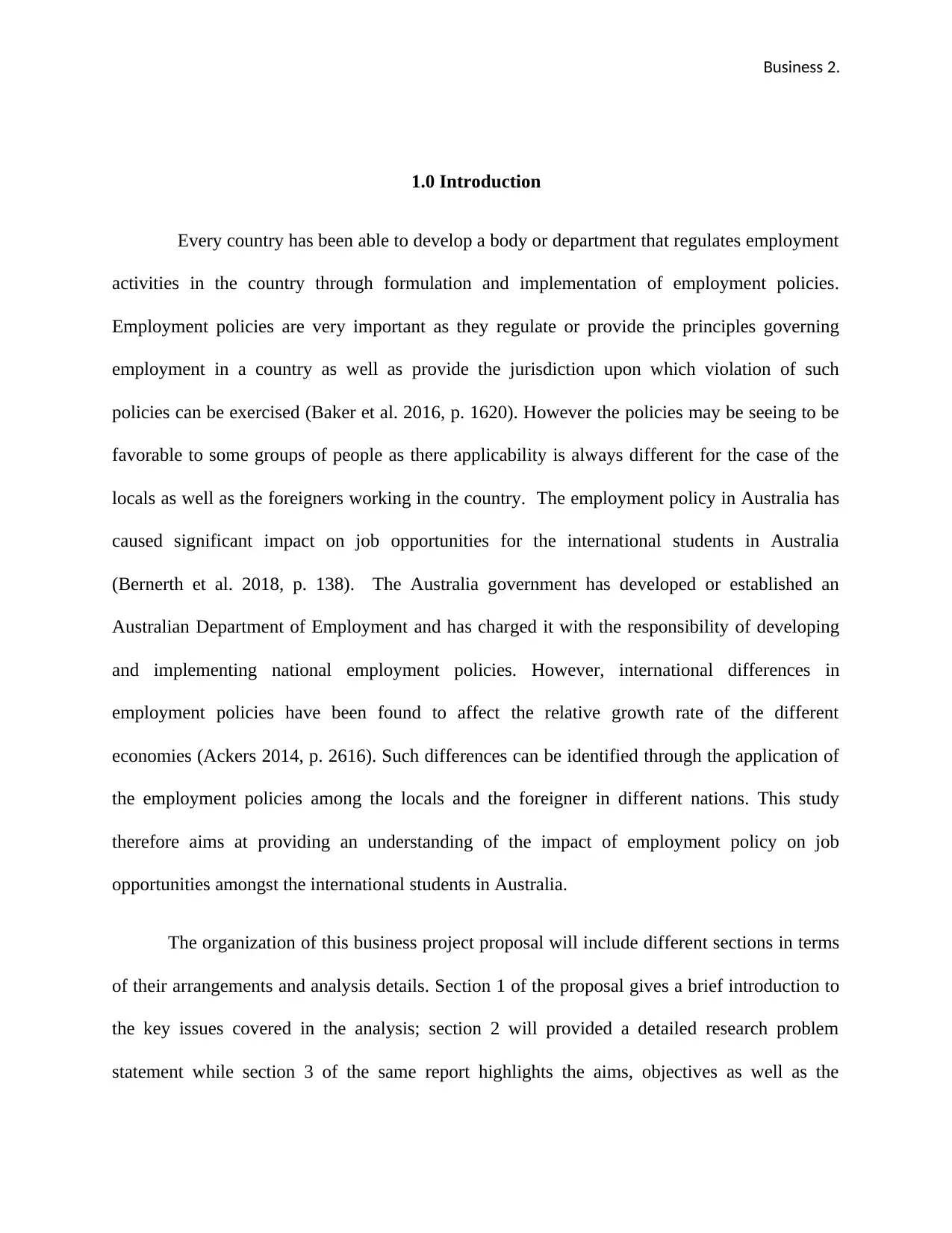
Business 2.
1.0 Introduction
Every country has been able to develop a body or department that regulates employment
activities in the country through formulation and implementation of employment policies.
Employment policies are very important as they regulate or provide the principles governing
employment in a country as well as provide the jurisdiction upon which violation of such
policies can be exercised (Baker et al. 2016, p. 1620). However the policies may be seeing to be
favorable to some groups of people as there applicability is always different for the case of the
locals as well as the foreigners working in the country. The employment policy in Australia has
caused significant impact on job opportunities for the international students in Australia
(Bernerth et al. 2018, p. 138). The Australia government has developed or established an
Australian Department of Employment and has charged it with the responsibility of developing
and implementing national employment policies. However, international differences in
employment policies have been found to affect the relative growth rate of the different
economies (Ackers 2014, p. 2616). Such differences can be identified through the application of
the employment policies among the locals and the foreigner in different nations. This study
therefore aims at providing an understanding of the impact of employment policy on job
opportunities amongst the international students in Australia.
The organization of this business project proposal will include different sections in terms
of their arrangements and analysis details. Section 1 of the proposal gives a brief introduction to
the key issues covered in the analysis; section 2 will provided a detailed research problem
statement while section 3 of the same report highlights the aims, objectives as well as the
1.0 Introduction
Every country has been able to develop a body or department that regulates employment
activities in the country through formulation and implementation of employment policies.
Employment policies are very important as they regulate or provide the principles governing
employment in a country as well as provide the jurisdiction upon which violation of such
policies can be exercised (Baker et al. 2016, p. 1620). However the policies may be seeing to be
favorable to some groups of people as there applicability is always different for the case of the
locals as well as the foreigners working in the country. The employment policy in Australia has
caused significant impact on job opportunities for the international students in Australia
(Bernerth et al. 2018, p. 138). The Australia government has developed or established an
Australian Department of Employment and has charged it with the responsibility of developing
and implementing national employment policies. However, international differences in
employment policies have been found to affect the relative growth rate of the different
economies (Ackers 2014, p. 2616). Such differences can be identified through the application of
the employment policies among the locals and the foreigner in different nations. This study
therefore aims at providing an understanding of the impact of employment policy on job
opportunities amongst the international students in Australia.
The organization of this business project proposal will include different sections in terms
of their arrangements and analysis details. Section 1 of the proposal gives a brief introduction to
the key issues covered in the analysis; section 2 will provided a detailed research problem
statement while section 3 of the same report highlights the aims, objectives as well as the
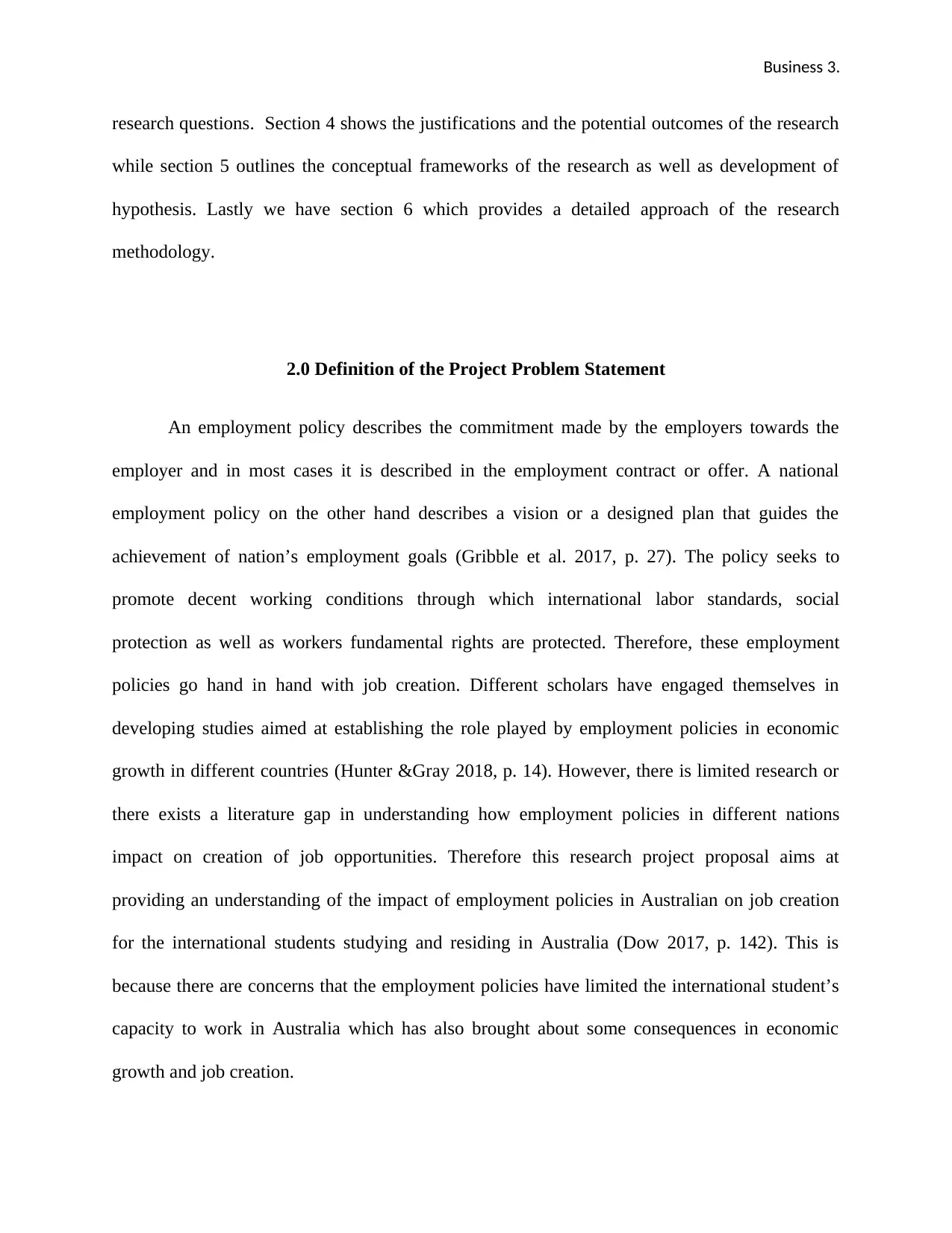
Business 3.
research questions. Section 4 shows the justifications and the potential outcomes of the research
while section 5 outlines the conceptual frameworks of the research as well as development of
hypothesis. Lastly we have section 6 which provides a detailed approach of the research
methodology.
2.0 Definition of the Project Problem Statement
An employment policy describes the commitment made by the employers towards the
employer and in most cases it is described in the employment contract or offer. A national
employment policy on the other hand describes a vision or a designed plan that guides the
achievement of nation’s employment goals (Gribble et al. 2017, p. 27). The policy seeks to
promote decent working conditions through which international labor standards, social
protection as well as workers fundamental rights are protected. Therefore, these employment
policies go hand in hand with job creation. Different scholars have engaged themselves in
developing studies aimed at establishing the role played by employment policies in economic
growth in different countries (Hunter &Gray 2018, p. 14). However, there is limited research or
there exists a literature gap in understanding how employment policies in different nations
impact on creation of job opportunities. Therefore this research project proposal aims at
providing an understanding of the impact of employment policies in Australian on job creation
for the international students studying and residing in Australia (Dow 2017, p. 142). This is
because there are concerns that the employment policies have limited the international student’s
capacity to work in Australia which has also brought about some consequences in economic
growth and job creation.
research questions. Section 4 shows the justifications and the potential outcomes of the research
while section 5 outlines the conceptual frameworks of the research as well as development of
hypothesis. Lastly we have section 6 which provides a detailed approach of the research
methodology.
2.0 Definition of the Project Problem Statement
An employment policy describes the commitment made by the employers towards the
employer and in most cases it is described in the employment contract or offer. A national
employment policy on the other hand describes a vision or a designed plan that guides the
achievement of nation’s employment goals (Gribble et al. 2017, p. 27). The policy seeks to
promote decent working conditions through which international labor standards, social
protection as well as workers fundamental rights are protected. Therefore, these employment
policies go hand in hand with job creation. Different scholars have engaged themselves in
developing studies aimed at establishing the role played by employment policies in economic
growth in different countries (Hunter &Gray 2018, p. 14). However, there is limited research or
there exists a literature gap in understanding how employment policies in different nations
impact on creation of job opportunities. Therefore this research project proposal aims at
providing an understanding of the impact of employment policies in Australian on job creation
for the international students studying and residing in Australia (Dow 2017, p. 142). This is
because there are concerns that the employment policies have limited the international student’s
capacity to work in Australia which has also brought about some consequences in economic
growth and job creation.
⊘ This is a preview!⊘
Do you want full access?
Subscribe today to unlock all pages.

Trusted by 1+ million students worldwide
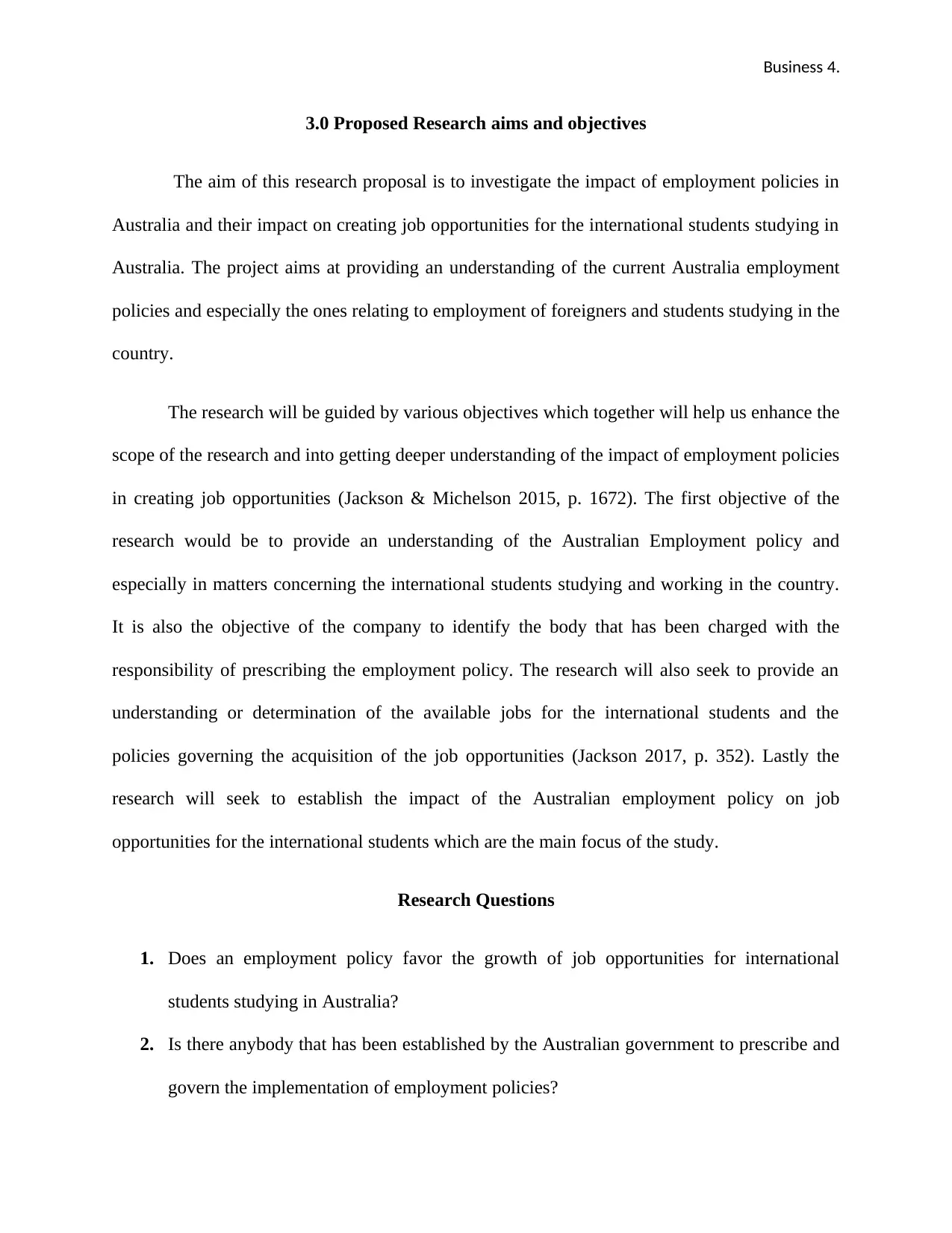
Business 4.
3.0 Proposed Research aims and objectives
The aim of this research proposal is to investigate the impact of employment policies in
Australia and their impact on creating job opportunities for the international students studying in
Australia. The project aims at providing an understanding of the current Australia employment
policies and especially the ones relating to employment of foreigners and students studying in the
country.
The research will be guided by various objectives which together will help us enhance the
scope of the research and into getting deeper understanding of the impact of employment policies
in creating job opportunities (Jackson & Michelson 2015, p. 1672). The first objective of the
research would be to provide an understanding of the Australian Employment policy and
especially in matters concerning the international students studying and working in the country.
It is also the objective of the company to identify the body that has been charged with the
responsibility of prescribing the employment policy. The research will also seek to provide an
understanding or determination of the available jobs for the international students and the
policies governing the acquisition of the job opportunities (Jackson 2017, p. 352). Lastly the
research will seek to establish the impact of the Australian employment policy on job
opportunities for the international students which are the main focus of the study.
Research Questions
1. Does an employment policy favor the growth of job opportunities for international
students studying in Australia?
2. Is there anybody that has been established by the Australian government to prescribe and
govern the implementation of employment policies?
3.0 Proposed Research aims and objectives
The aim of this research proposal is to investigate the impact of employment policies in
Australia and their impact on creating job opportunities for the international students studying in
Australia. The project aims at providing an understanding of the current Australia employment
policies and especially the ones relating to employment of foreigners and students studying in the
country.
The research will be guided by various objectives which together will help us enhance the
scope of the research and into getting deeper understanding of the impact of employment policies
in creating job opportunities (Jackson & Michelson 2015, p. 1672). The first objective of the
research would be to provide an understanding of the Australian Employment policy and
especially in matters concerning the international students studying and working in the country.
It is also the objective of the company to identify the body that has been charged with the
responsibility of prescribing the employment policy. The research will also seek to provide an
understanding or determination of the available jobs for the international students and the
policies governing the acquisition of the job opportunities (Jackson 2017, p. 352). Lastly the
research will seek to establish the impact of the Australian employment policy on job
opportunities for the international students which are the main focus of the study.
Research Questions
1. Does an employment policy favor the growth of job opportunities for international
students studying in Australia?
2. Is there anybody that has been established by the Australian government to prescribe and
govern the implementation of employment policies?
Paraphrase This Document
Need a fresh take? Get an instant paraphrase of this document with our AI Paraphraser
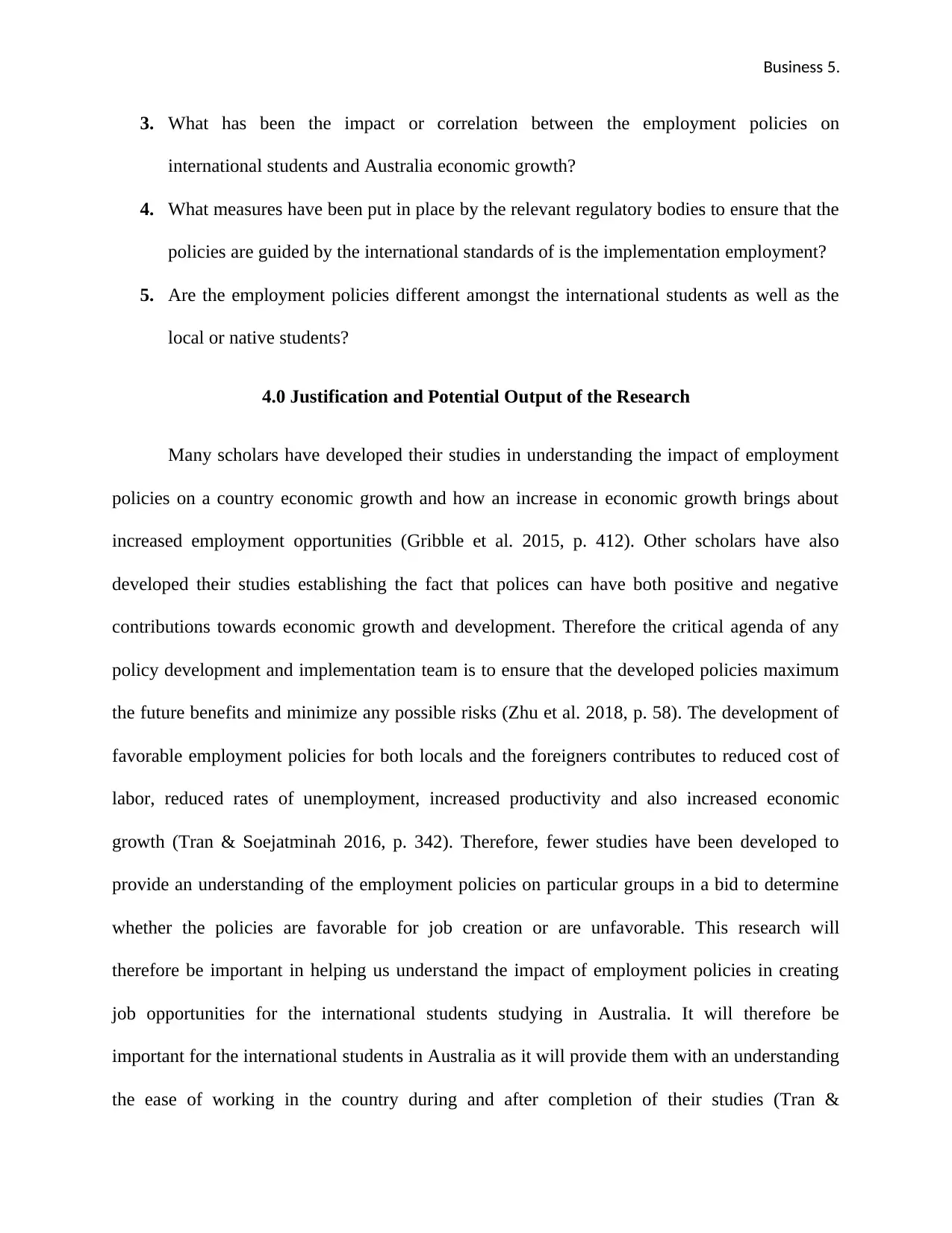
Business 5.
3. What has been the impact or correlation between the employment policies on
international students and Australia economic growth?
4. What measures have been put in place by the relevant regulatory bodies to ensure that the
policies are guided by the international standards of is the implementation employment?
5. Are the employment policies different amongst the international students as well as the
local or native students?
4.0 Justification and Potential Output of the Research
Many scholars have developed their studies in understanding the impact of employment
policies on a country economic growth and how an increase in economic growth brings about
increased employment opportunities (Gribble et al. 2015, p. 412). Other scholars have also
developed their studies establishing the fact that polices can have both positive and negative
contributions towards economic growth and development. Therefore the critical agenda of any
policy development and implementation team is to ensure that the developed policies maximum
the future benefits and minimize any possible risks (Zhu et al. 2018, p. 58). The development of
favorable employment policies for both locals and the foreigners contributes to reduced cost of
labor, reduced rates of unemployment, increased productivity and also increased economic
growth (Tran & Soejatminah 2016, p. 342). Therefore, fewer studies have been developed to
provide an understanding of the employment policies on particular groups in a bid to determine
whether the policies are favorable for job creation or are unfavorable. This research will
therefore be important in helping us understand the impact of employment policies in creating
job opportunities for the international students studying in Australia. It will therefore be
important for the international students in Australia as it will provide them with an understanding
the ease of working in the country during and after completion of their studies (Tran &
3. What has been the impact or correlation between the employment policies on
international students and Australia economic growth?
4. What measures have been put in place by the relevant regulatory bodies to ensure that the
policies are guided by the international standards of is the implementation employment?
5. Are the employment policies different amongst the international students as well as the
local or native students?
4.0 Justification and Potential Output of the Research
Many scholars have developed their studies in understanding the impact of employment
policies on a country economic growth and how an increase in economic growth brings about
increased employment opportunities (Gribble et al. 2015, p. 412). Other scholars have also
developed their studies establishing the fact that polices can have both positive and negative
contributions towards economic growth and development. Therefore the critical agenda of any
policy development and implementation team is to ensure that the developed policies maximum
the future benefits and minimize any possible risks (Zhu et al. 2018, p. 58). The development of
favorable employment policies for both locals and the foreigners contributes to reduced cost of
labor, reduced rates of unemployment, increased productivity and also increased economic
growth (Tran & Soejatminah 2016, p. 342). Therefore, fewer studies have been developed to
provide an understanding of the employment policies on particular groups in a bid to determine
whether the policies are favorable for job creation or are unfavorable. This research will
therefore be important in helping us understand the impact of employment policies in creating
job opportunities for the international students studying in Australia. It will therefore be
important for the international students in Australia as it will provide them with an understanding
the ease of working in the country during and after completion of their studies (Tran &
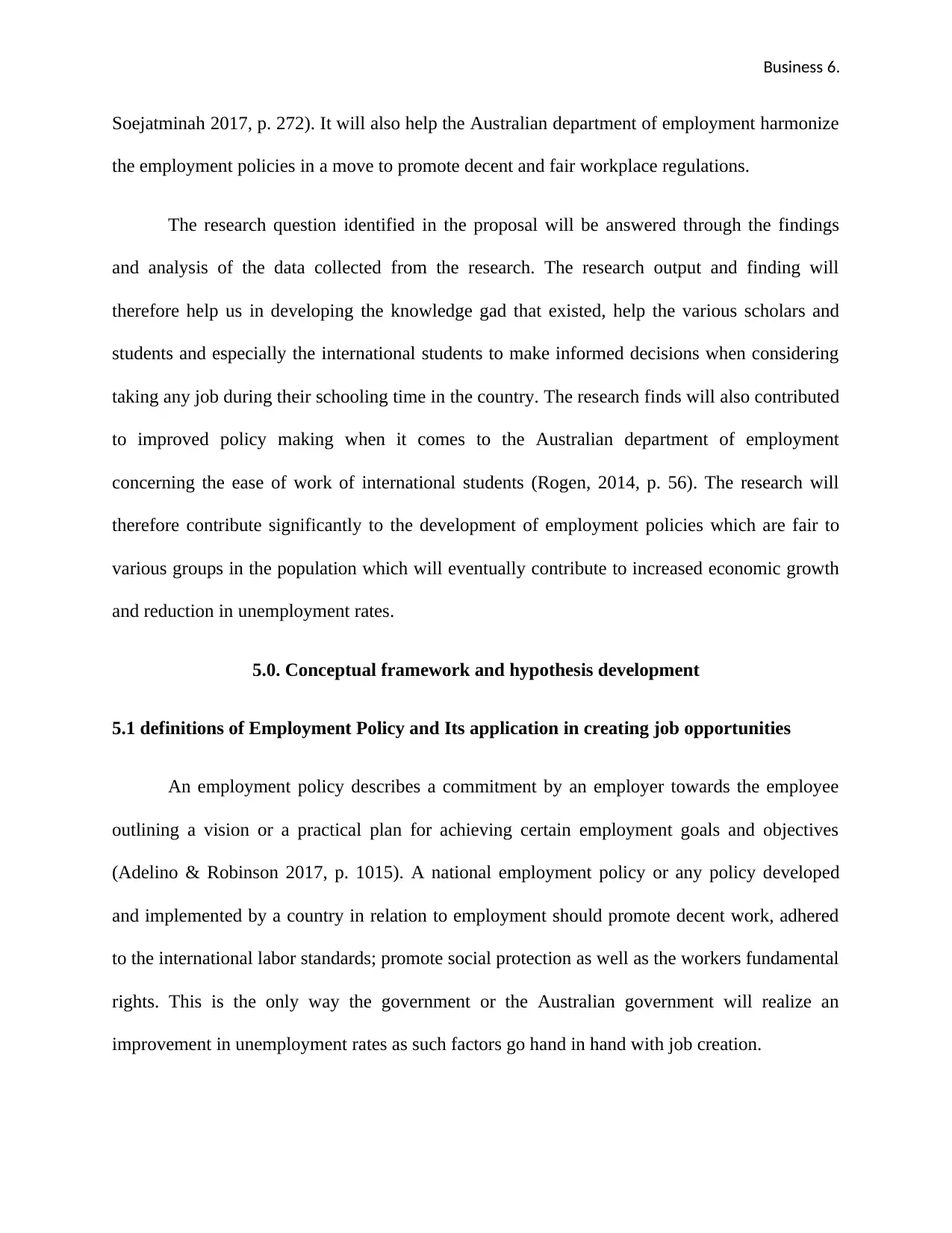
Business 6.
Soejatminah 2017, p. 272). It will also help the Australian department of employment harmonize
the employment policies in a move to promote decent and fair workplace regulations.
The research question identified in the proposal will be answered through the findings
and analysis of the data collected from the research. The research output and finding will
therefore help us in developing the knowledge gad that existed, help the various scholars and
students and especially the international students to make informed decisions when considering
taking any job during their schooling time in the country. The research finds will also contributed
to improved policy making when it comes to the Australian department of employment
concerning the ease of work of international students (Rogen, 2014, p. 56). The research will
therefore contribute significantly to the development of employment policies which are fair to
various groups in the population which will eventually contribute to increased economic growth
and reduction in unemployment rates.
5.0. Conceptual framework and hypothesis development
5.1 definitions of Employment Policy and Its application in creating job opportunities
An employment policy describes a commitment by an employer towards the employee
outlining a vision or a practical plan for achieving certain employment goals and objectives
(Adelino & Robinson 2017, p. 1015). A national employment policy or any policy developed
and implemented by a country in relation to employment should promote decent work, adhered
to the international labor standards; promote social protection as well as the workers fundamental
rights. This is the only way the government or the Australian government will realize an
improvement in unemployment rates as such factors go hand in hand with job creation.
Soejatminah 2017, p. 272). It will also help the Australian department of employment harmonize
the employment policies in a move to promote decent and fair workplace regulations.
The research question identified in the proposal will be answered through the findings
and analysis of the data collected from the research. The research output and finding will
therefore help us in developing the knowledge gad that existed, help the various scholars and
students and especially the international students to make informed decisions when considering
taking any job during their schooling time in the country. The research finds will also contributed
to improved policy making when it comes to the Australian department of employment
concerning the ease of work of international students (Rogen, 2014, p. 56). The research will
therefore contribute significantly to the development of employment policies which are fair to
various groups in the population which will eventually contribute to increased economic growth
and reduction in unemployment rates.
5.0. Conceptual framework and hypothesis development
5.1 definitions of Employment Policy and Its application in creating job opportunities
An employment policy describes a commitment by an employer towards the employee
outlining a vision or a practical plan for achieving certain employment goals and objectives
(Adelino & Robinson 2017, p. 1015). A national employment policy or any policy developed
and implemented by a country in relation to employment should promote decent work, adhered
to the international labor standards; promote social protection as well as the workers fundamental
rights. This is the only way the government or the Australian government will realize an
improvement in unemployment rates as such factors go hand in hand with job creation.
⊘ This is a preview!⊘
Do you want full access?
Subscribe today to unlock all pages.

Trusted by 1+ million students worldwide
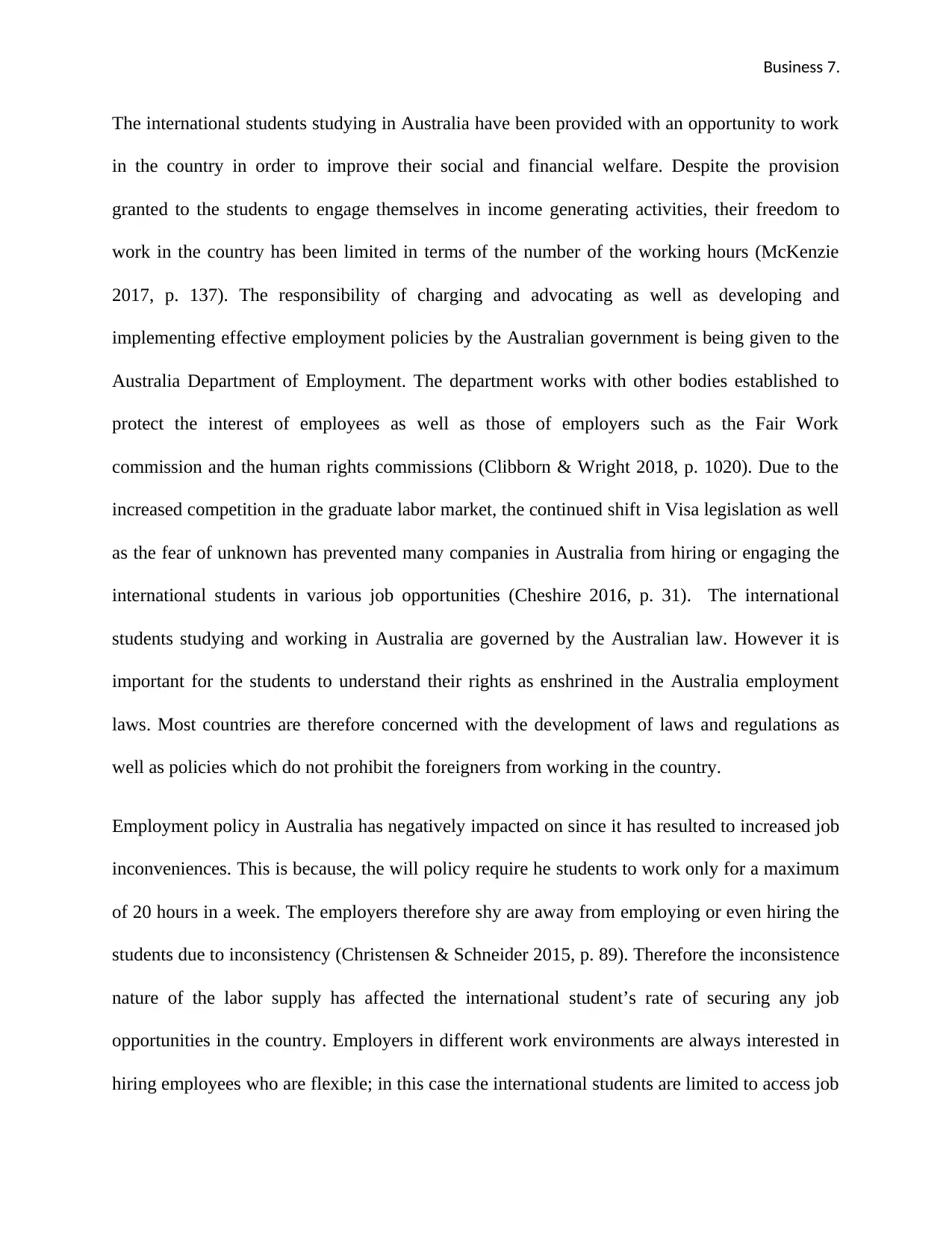
Business 7.
The international students studying in Australia have been provided with an opportunity to work
in the country in order to improve their social and financial welfare. Despite the provision
granted to the students to engage themselves in income generating activities, their freedom to
work in the country has been limited in terms of the number of the working hours (McKenzie
2017, p. 137). The responsibility of charging and advocating as well as developing and
implementing effective employment policies by the Australian government is being given to the
Australia Department of Employment. The department works with other bodies established to
protect the interest of employees as well as those of employers such as the Fair Work
commission and the human rights commissions (Clibborn & Wright 2018, p. 1020). Due to the
increased competition in the graduate labor market, the continued shift in Visa legislation as well
as the fear of unknown has prevented many companies in Australia from hiring or engaging the
international students in various job opportunities (Cheshire 2016, p. 31). The international
students studying and working in Australia are governed by the Australian law. However it is
important for the students to understand their rights as enshrined in the Australia employment
laws. Most countries are therefore concerned with the development of laws and regulations as
well as policies which do not prohibit the foreigners from working in the country.
Employment policy in Australia has negatively impacted on since it has resulted to increased job
inconveniences. This is because, the will policy require he students to work only for a maximum
of 20 hours in a week. The employers therefore shy are away from employing or even hiring the
students due to inconsistency (Christensen & Schneider 2015, p. 89). Therefore the inconsistence
nature of the labor supply has affected the international student’s rate of securing any job
opportunities in the country. Employers in different work environments are always interested in
hiring employees who are flexible; in this case the international students are limited to access job
The international students studying in Australia have been provided with an opportunity to work
in the country in order to improve their social and financial welfare. Despite the provision
granted to the students to engage themselves in income generating activities, their freedom to
work in the country has been limited in terms of the number of the working hours (McKenzie
2017, p. 137). The responsibility of charging and advocating as well as developing and
implementing effective employment policies by the Australian government is being given to the
Australia Department of Employment. The department works with other bodies established to
protect the interest of employees as well as those of employers such as the Fair Work
commission and the human rights commissions (Clibborn & Wright 2018, p. 1020). Due to the
increased competition in the graduate labor market, the continued shift in Visa legislation as well
as the fear of unknown has prevented many companies in Australia from hiring or engaging the
international students in various job opportunities (Cheshire 2016, p. 31). The international
students studying and working in Australia are governed by the Australian law. However it is
important for the students to understand their rights as enshrined in the Australia employment
laws. Most countries are therefore concerned with the development of laws and regulations as
well as policies which do not prohibit the foreigners from working in the country.
Employment policy in Australia has negatively impacted on since it has resulted to increased job
inconveniences. This is because, the will policy require he students to work only for a maximum
of 20 hours in a week. The employers therefore shy are away from employing or even hiring the
students due to inconsistency (Christensen & Schneider 2015, p. 89). Therefore the inconsistence
nature of the labor supply has affected the international student’s rate of securing any job
opportunities in the country. Employers in different work environments are always interested in
hiring employees who are flexible; in this case the international students are limited to access job
Paraphrase This Document
Need a fresh take? Get an instant paraphrase of this document with our AI Paraphraser
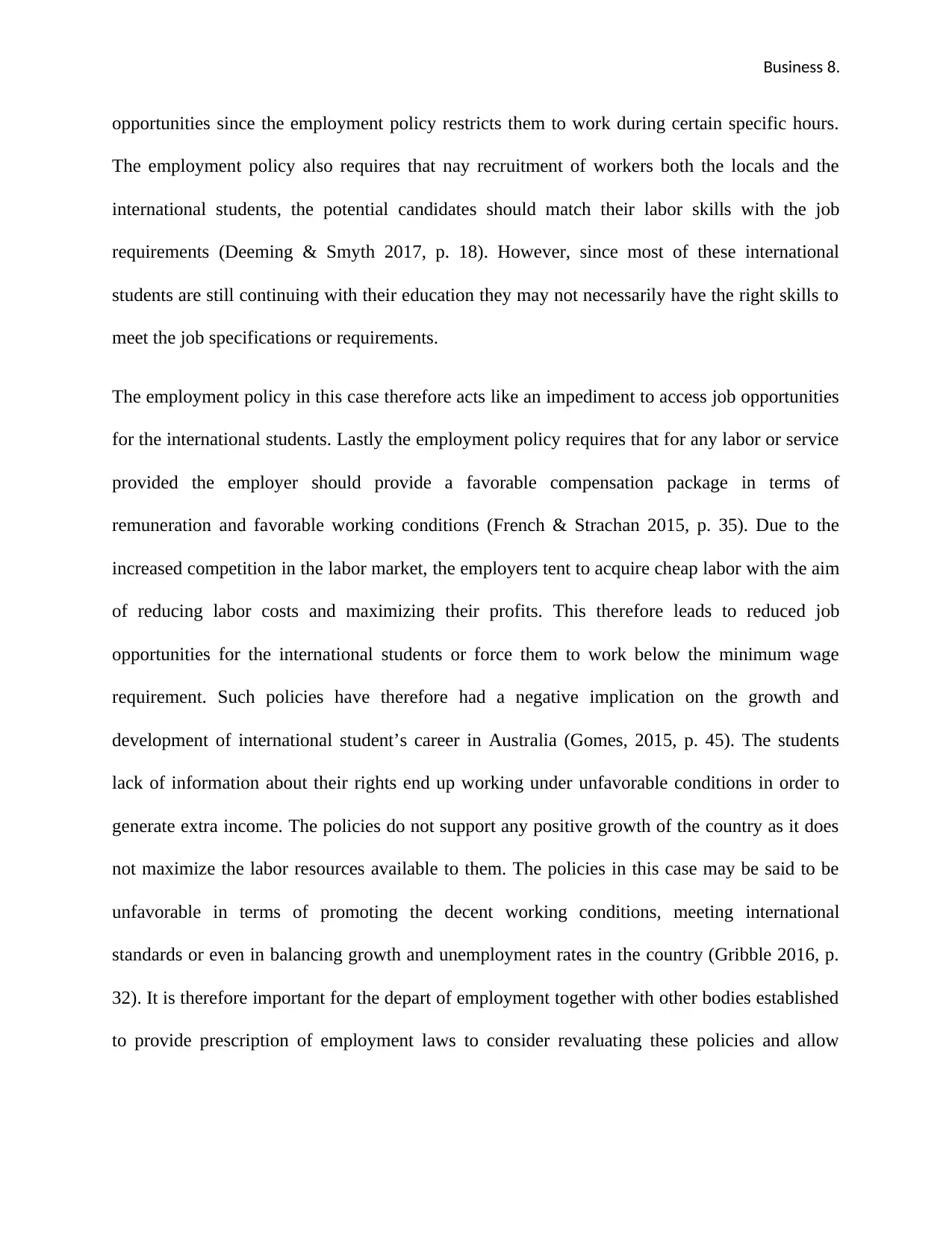
Business 8.
opportunities since the employment policy restricts them to work during certain specific hours.
The employment policy also requires that nay recruitment of workers both the locals and the
international students, the potential candidates should match their labor skills with the job
requirements (Deeming & Smyth 2017, p. 18). However, since most of these international
students are still continuing with their education they may not necessarily have the right skills to
meet the job specifications or requirements.
The employment policy in this case therefore acts like an impediment to access job opportunities
for the international students. Lastly the employment policy requires that for any labor or service
provided the employer should provide a favorable compensation package in terms of
remuneration and favorable working conditions (French & Strachan 2015, p. 35). Due to the
increased competition in the labor market, the employers tent to acquire cheap labor with the aim
of reducing labor costs and maximizing their profits. This therefore leads to reduced job
opportunities for the international students or force them to work below the minimum wage
requirement. Such policies have therefore had a negative implication on the growth and
development of international student’s career in Australia (Gomes, 2015, p. 45). The students
lack of information about their rights end up working under unfavorable conditions in order to
generate extra income. The policies do not support any positive growth of the country as it does
not maximize the labor resources available to them. The policies in this case may be said to be
unfavorable in terms of promoting the decent working conditions, meeting international
standards or even in balancing growth and unemployment rates in the country (Gribble 2016, p.
32). It is therefore important for the depart of employment together with other bodies established
to provide prescription of employment laws to consider revaluating these policies and allow
opportunities since the employment policy restricts them to work during certain specific hours.
The employment policy also requires that nay recruitment of workers both the locals and the
international students, the potential candidates should match their labor skills with the job
requirements (Deeming & Smyth 2017, p. 18). However, since most of these international
students are still continuing with their education they may not necessarily have the right skills to
meet the job specifications or requirements.
The employment policy in this case therefore acts like an impediment to access job opportunities
for the international students. Lastly the employment policy requires that for any labor or service
provided the employer should provide a favorable compensation package in terms of
remuneration and favorable working conditions (French & Strachan 2015, p. 35). Due to the
increased competition in the labor market, the employers tent to acquire cheap labor with the aim
of reducing labor costs and maximizing their profits. This therefore leads to reduced job
opportunities for the international students or force them to work below the minimum wage
requirement. Such policies have therefore had a negative implication on the growth and
development of international student’s career in Australia (Gomes, 2015, p. 45). The students
lack of information about their rights end up working under unfavorable conditions in order to
generate extra income. The policies do not support any positive growth of the country as it does
not maximize the labor resources available to them. The policies in this case may be said to be
unfavorable in terms of promoting the decent working conditions, meeting international
standards or even in balancing growth and unemployment rates in the country (Gribble 2016, p.
32). It is therefore important for the depart of employment together with other bodies established
to provide prescription of employment laws to consider revaluating these policies and allow
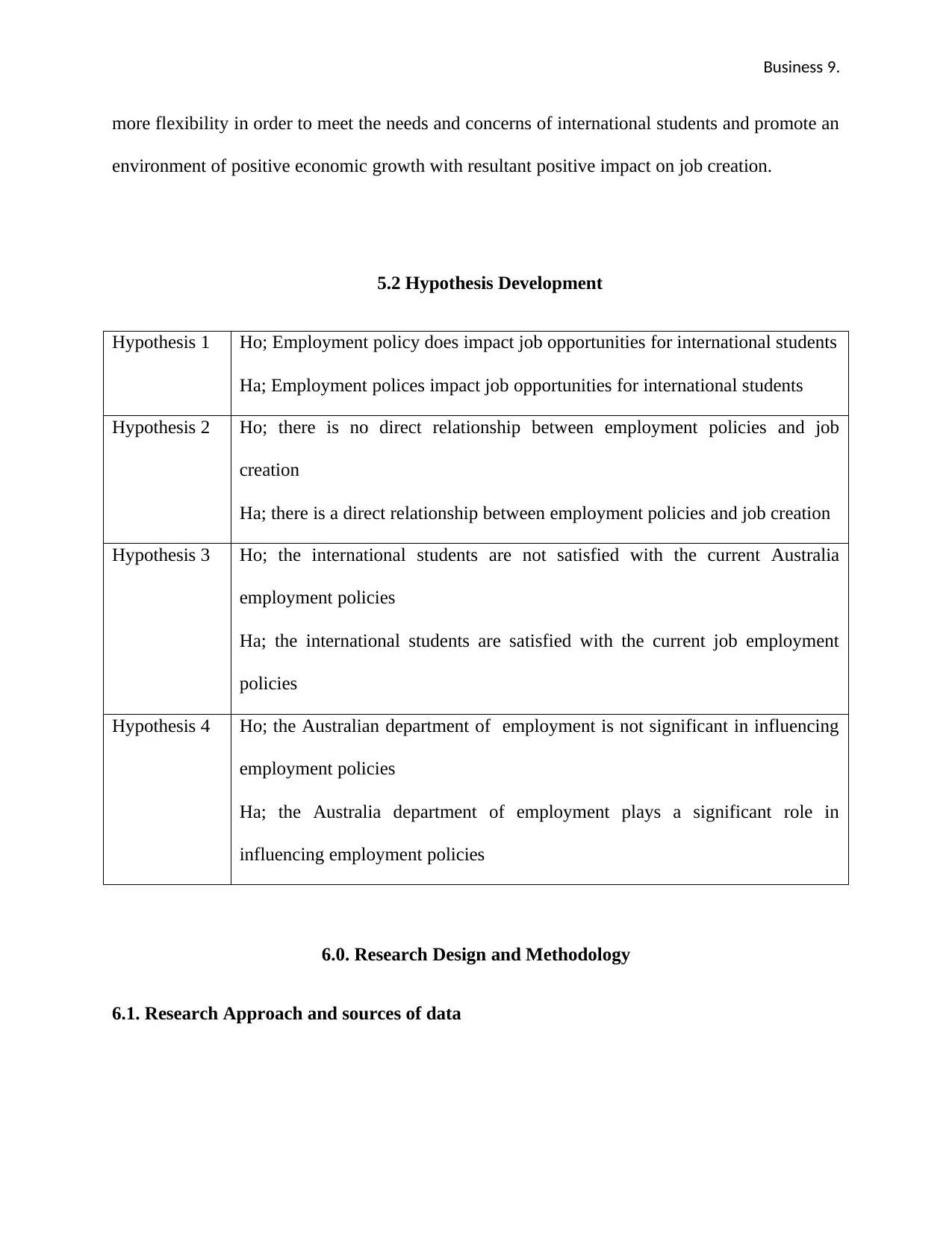
Business 9.
more flexibility in order to meet the needs and concerns of international students and promote an
environment of positive economic growth with resultant positive impact on job creation.
5.2 Hypothesis Development
Hypothesis 1 Ho; Employment policy does impact job opportunities for international students
Ha; Employment polices impact job opportunities for international students
Hypothesis 2 Ho; there is no direct relationship between employment policies and job
creation
Ha; there is a direct relationship between employment policies and job creation
Hypothesis 3 Ho; the international students are not satisfied with the current Australia
employment policies
Ha; the international students are satisfied with the current job employment
policies
Hypothesis 4 Ho; the Australian department of employment is not significant in influencing
employment policies
Ha; the Australia department of employment plays a significant role in
influencing employment policies
6.0. Research Design and Methodology
6.1. Research Approach and sources of data
more flexibility in order to meet the needs and concerns of international students and promote an
environment of positive economic growth with resultant positive impact on job creation.
5.2 Hypothesis Development
Hypothesis 1 Ho; Employment policy does impact job opportunities for international students
Ha; Employment polices impact job opportunities for international students
Hypothesis 2 Ho; there is no direct relationship between employment policies and job
creation
Ha; there is a direct relationship between employment policies and job creation
Hypothesis 3 Ho; the international students are not satisfied with the current Australia
employment policies
Ha; the international students are satisfied with the current job employment
policies
Hypothesis 4 Ho; the Australian department of employment is not significant in influencing
employment policies
Ha; the Australia department of employment plays a significant role in
influencing employment policies
6.0. Research Design and Methodology
6.1. Research Approach and sources of data
⊘ This is a preview!⊘
Do you want full access?
Subscribe today to unlock all pages.

Trusted by 1+ million students worldwide
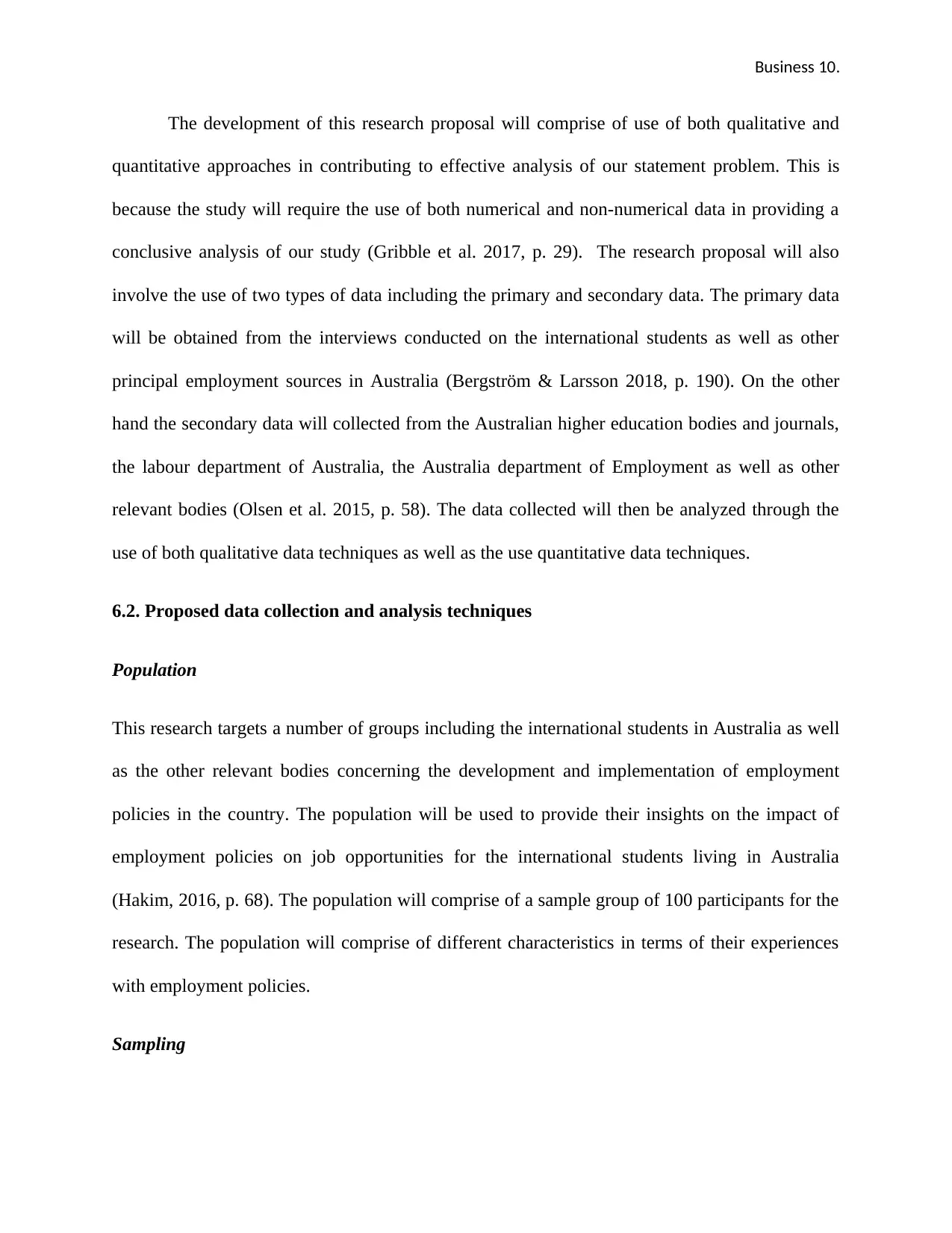
Business 10.
The development of this research proposal will comprise of use of both qualitative and
quantitative approaches in contributing to effective analysis of our statement problem. This is
because the study will require the use of both numerical and non-numerical data in providing a
conclusive analysis of our study (Gribble et al. 2017, p. 29). The research proposal will also
involve the use of two types of data including the primary and secondary data. The primary data
will be obtained from the interviews conducted on the international students as well as other
principal employment sources in Australia (Bergström & Larsson 2018, p. 190). On the other
hand the secondary data will collected from the Australian higher education bodies and journals,
the labour department of Australia, the Australia department of Employment as well as other
relevant bodies (Olsen et al. 2015, p. 58). The data collected will then be analyzed through the
use of both qualitative data techniques as well as the use quantitative data techniques.
6.2. Proposed data collection and analysis techniques
Population
This research targets a number of groups including the international students in Australia as well
as the other relevant bodies concerning the development and implementation of employment
policies in the country. The population will be used to provide their insights on the impact of
employment policies on job opportunities for the international students living in Australia
(Hakim, 2016, p. 68). The population will comprise of a sample group of 100 participants for the
research. The population will comprise of different characteristics in terms of their experiences
with employment policies.
Sampling
The development of this research proposal will comprise of use of both qualitative and
quantitative approaches in contributing to effective analysis of our statement problem. This is
because the study will require the use of both numerical and non-numerical data in providing a
conclusive analysis of our study (Gribble et al. 2017, p. 29). The research proposal will also
involve the use of two types of data including the primary and secondary data. The primary data
will be obtained from the interviews conducted on the international students as well as other
principal employment sources in Australia (Bergström & Larsson 2018, p. 190). On the other
hand the secondary data will collected from the Australian higher education bodies and journals,
the labour department of Australia, the Australia department of Employment as well as other
relevant bodies (Olsen et al. 2015, p. 58). The data collected will then be analyzed through the
use of both qualitative data techniques as well as the use quantitative data techniques.
6.2. Proposed data collection and analysis techniques
Population
This research targets a number of groups including the international students in Australia as well
as the other relevant bodies concerning the development and implementation of employment
policies in the country. The population will be used to provide their insights on the impact of
employment policies on job opportunities for the international students living in Australia
(Hakim, 2016, p. 68). The population will comprise of a sample group of 100 participants for the
research. The population will comprise of different characteristics in terms of their experiences
with employment policies.
Sampling
Paraphrase This Document
Need a fresh take? Get an instant paraphrase of this document with our AI Paraphraser
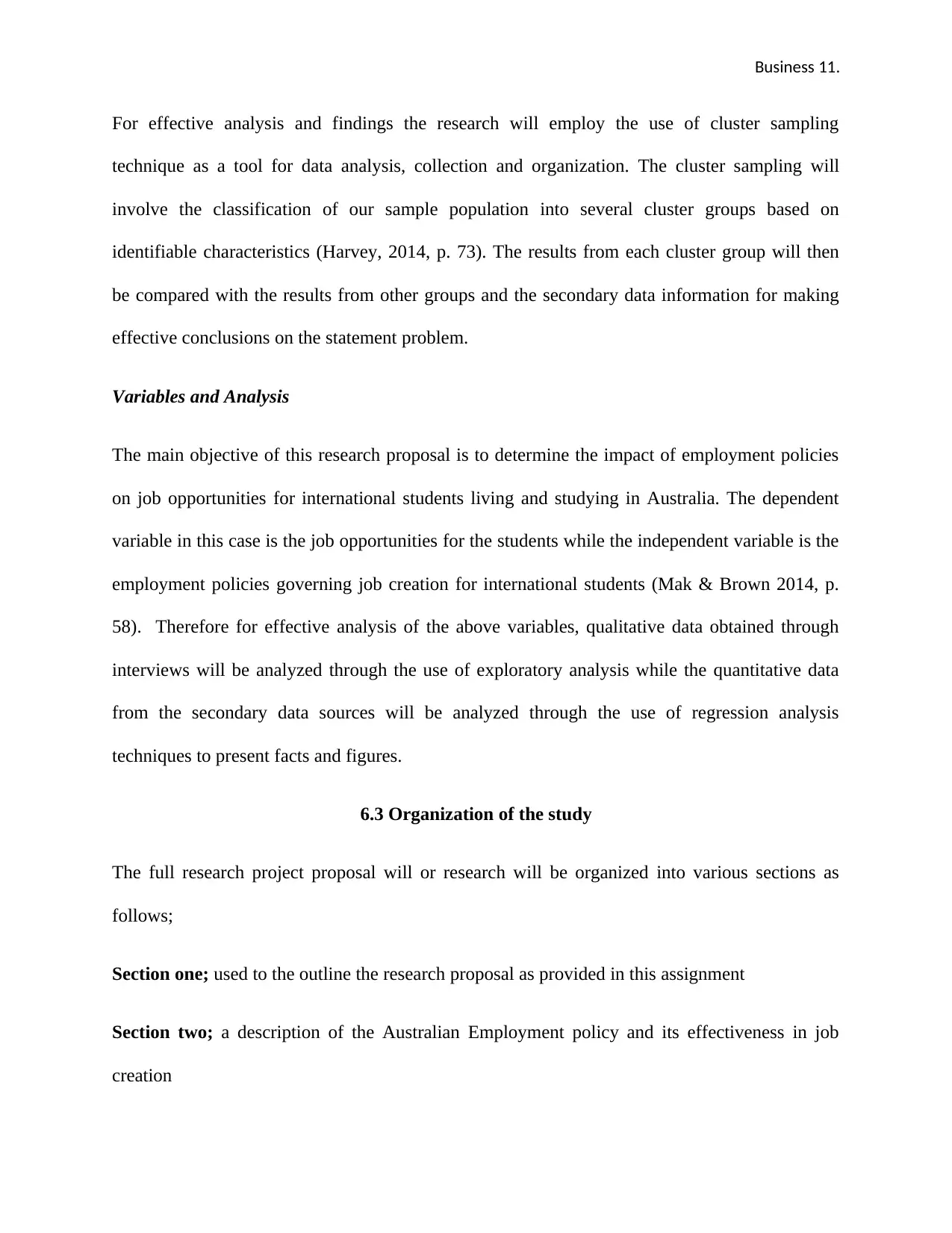
Business 11.
For effective analysis and findings the research will employ the use of cluster sampling
technique as a tool for data analysis, collection and organization. The cluster sampling will
involve the classification of our sample population into several cluster groups based on
identifiable characteristics (Harvey, 2014, p. 73). The results from each cluster group will then
be compared with the results from other groups and the secondary data information for making
effective conclusions on the statement problem.
Variables and Analysis
The main objective of this research proposal is to determine the impact of employment policies
on job opportunities for international students living and studying in Australia. The dependent
variable in this case is the job opportunities for the students while the independent variable is the
employment policies governing job creation for international students (Mak & Brown 2014, p.
58). Therefore for effective analysis of the above variables, qualitative data obtained through
interviews will be analyzed through the use of exploratory analysis while the quantitative data
from the secondary data sources will be analyzed through the use of regression analysis
techniques to present facts and figures.
6.3 Organization of the study
The full research project proposal will or research will be organized into various sections as
follows;
Section one; used to the outline the research proposal as provided in this assignment
Section two; a description of the Australian Employment policy and its effectiveness in job
creation
For effective analysis and findings the research will employ the use of cluster sampling
technique as a tool for data analysis, collection and organization. The cluster sampling will
involve the classification of our sample population into several cluster groups based on
identifiable characteristics (Harvey, 2014, p. 73). The results from each cluster group will then
be compared with the results from other groups and the secondary data information for making
effective conclusions on the statement problem.
Variables and Analysis
The main objective of this research proposal is to determine the impact of employment policies
on job opportunities for international students living and studying in Australia. The dependent
variable in this case is the job opportunities for the students while the independent variable is the
employment policies governing job creation for international students (Mak & Brown 2014, p.
58). Therefore for effective analysis of the above variables, qualitative data obtained through
interviews will be analyzed through the use of exploratory analysis while the quantitative data
from the secondary data sources will be analyzed through the use of regression analysis
techniques to present facts and figures.
6.3 Organization of the study
The full research project proposal will or research will be organized into various sections as
follows;
Section one; used to the outline the research proposal as provided in this assignment
Section two; a description of the Australian Employment policy and its effectiveness in job
creation
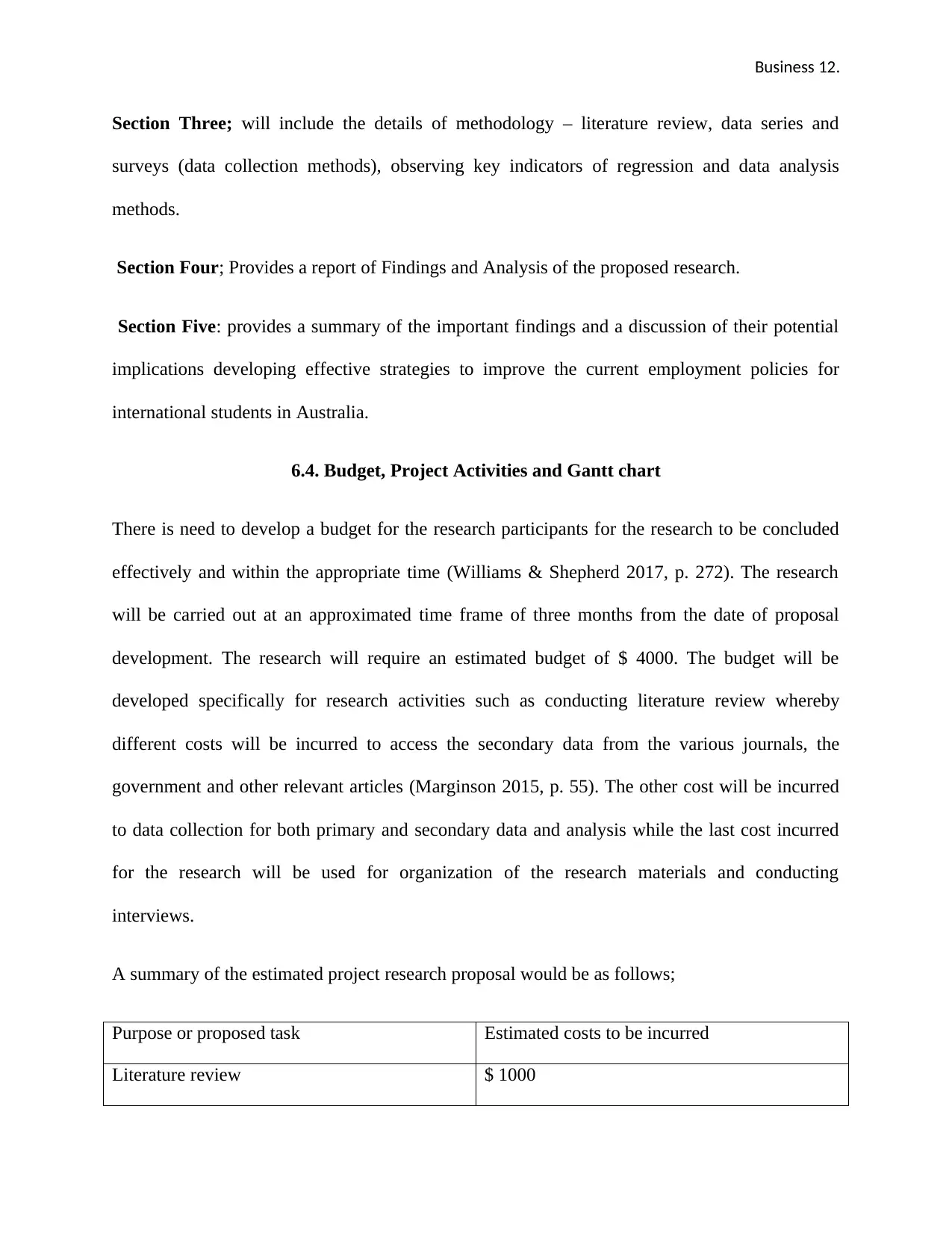
Business 12.
Section Three; will include the details of methodology – literature review, data series and
surveys (data collection methods), observing key indicators of regression and data analysis
methods.
Section Four; Provides a report of Findings and Analysis of the proposed research.
Section Five: provides a summary of the important findings and a discussion of their potential
implications developing effective strategies to improve the current employment policies for
international students in Australia.
6.4. Budget, Project Activities and Gantt chart
There is need to develop a budget for the research participants for the research to be concluded
effectively and within the appropriate time (Williams & Shepherd 2017, p. 272). The research
will be carried out at an approximated time frame of three months from the date of proposal
development. The research will require an estimated budget of $ 4000. The budget will be
developed specifically for research activities such as conducting literature review whereby
different costs will be incurred to access the secondary data from the various journals, the
government and other relevant articles (Marginson 2015, p. 55). The other cost will be incurred
to data collection for both primary and secondary data and analysis while the last cost incurred
for the research will be used for organization of the research materials and conducting
interviews.
A summary of the estimated project research proposal would be as follows;
Purpose or proposed task Estimated costs to be incurred
Literature review $ 1000
Section Three; will include the details of methodology – literature review, data series and
surveys (data collection methods), observing key indicators of regression and data analysis
methods.
Section Four; Provides a report of Findings and Analysis of the proposed research.
Section Five: provides a summary of the important findings and a discussion of their potential
implications developing effective strategies to improve the current employment policies for
international students in Australia.
6.4. Budget, Project Activities and Gantt chart
There is need to develop a budget for the research participants for the research to be concluded
effectively and within the appropriate time (Williams & Shepherd 2017, p. 272). The research
will be carried out at an approximated time frame of three months from the date of proposal
development. The research will require an estimated budget of $ 4000. The budget will be
developed specifically for research activities such as conducting literature review whereby
different costs will be incurred to access the secondary data from the various journals, the
government and other relevant articles (Marginson 2015, p. 55). The other cost will be incurred
to data collection for both primary and secondary data and analysis while the last cost incurred
for the research will be used for organization of the research materials and conducting
interviews.
A summary of the estimated project research proposal would be as follows;
Purpose or proposed task Estimated costs to be incurred
Literature review $ 1000
⊘ This is a preview!⊘
Do you want full access?
Subscribe today to unlock all pages.

Trusted by 1+ million students worldwide
1 out of 17
Related Documents
Your All-in-One AI-Powered Toolkit for Academic Success.
+13062052269
info@desklib.com
Available 24*7 on WhatsApp / Email
![[object Object]](/_next/static/media/star-bottom.7253800d.svg)
Unlock your academic potential
Copyright © 2020–2025 A2Z Services. All Rights Reserved. Developed and managed by ZUCOL.




